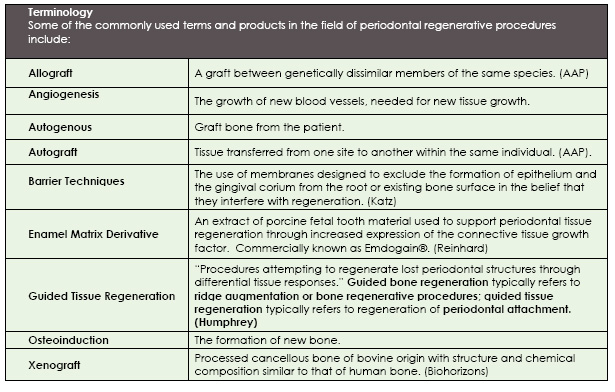Trammell Periodontics Newsletter Article
by Kyle Trammell, D.M.D.
While the first order of business in managing a patient’s periodontal health is to eliminate infection and disease, the question of “how do we replace what has been lost?” is one that is pondered daily in our profession. The study of the periodontal repair and regeneration of soft tissue and bone has seen major changes over the last twenty years; surgical techniques have been taken to a new level through the development of regenerative products designed and tested specifically for the oral tissues.
CASE EXAMPLES: In Case Examples 1 and 2, these patients present with vertical intrabony defects. Assuming that all other oral health needs are stable and well-managed, the challenge becomes the inherent difficulties in repairing and rebuilding the bone, periodontal ligament and soft tissue to prevent further damage and tooth loss while also attempting to regenerate the lost alveolar bone, PDL and cementum.

GUIDED BONE REGENERATION (GBR) AND GUIDED TISSUE REGENERATION (GTR):
We would agree that the treatment plan for these situations would likely include periodontal surgery for access and root surface debridement to reduce bacterial levels and promote healing. In these cases, each of the treating periodontists employed Guided Tissue Regeneration (GTR) surgical procedures to facilitate the growth of bone and fill the defect.
Beyond the surgery itself, GBR and GTR typically involve the use of membranes (filters), bone and tissue grafts or tissue-stimulating proteins that are designed to interact with the body’s natural healing and regenerative processes. The strategic objective of these products is to retard the downgrowth of gingival tissues, provide space maintenance, and promote new cementum, alveolar bone, and periodontal ligament cells.
WHERE REPAIR AND REGENERATION OVERLAP
In dental practice, we address one patient at a time. When we achieve results as in the examples provided, we would describe these as successful outcomes and probably not argue “what is repair vs. regeneration”? In the scientific arena, analysts would tell us that the only way to verify “regeneration” would be to obtain tissue samples followed by histological studies. Katz describes guided tissue regeneration as verified by through histological analysis as a form of repair termed “new attachment” (2013). So, the claim that we can “grow tissue” is perhaps better stated that we can “repair loss of tissue and bone”. Semantics, maybe, but also an indication of how wide and vast this area of research has become.
WHO ARE CANDIDATES FOR GUIDED TISSUE REGENERATION PROCEDURES?
Patients that would likely benefit from regenerative periodontal surgical procedures are those that present with vertical bony defects evident on radiographs and localized deep probing depths. As with any dental treatment, healthy patients have a better treatment prognosis than those with systemic medical conditions, but certainly this will vary on a case by case basis. Also, smokers have much less predictable regenerative results than do non-smokers. A combined radiographic and clinical examination is needed to determine potential sites for regeneration; however, sites that are potential candidates are usually confirmed intrasurgically when the defect can be fully visualized.

HOW ARE REGENERATIVE PROCEDURES DIFFERENT FROM CONVENTIONAL TREATMENT?
In comparison, surgical bone and tissue regenerative procedures are closely related to soft tissue grafting procedures for addressing gingival recession, but are generally more invasive and require longer healing times.
Post-surgical healing is also different – in traditional surgical and non-surgical therapy, tissue response and growth is limited to the most apical portion of the defect along the root surface. A positive response to regenerative periodontal surgery will stimulate differential tissue response, which increases bone levels, clinical Attachment levels and reduces pocket probing depths. Humphrey states, “the use of regenerative periodontal procedures that include bone graft materials and membranes generally produce greater intrabony bone defect fill than flap debridement alone” (2014).
THE FUTURE OF PERIODONTAL REGENERATION
Future efforts in the study of regeneration will likely focus on controlling this process to create predictable outcomes. As we continue to manage the oral health of our aging “baby boomer” population, the demand for services that help patients keep their teeth and support an enjoyable quality of life will continue to inspire researchers and practitioners alike in this area of practice.
Article References:
American Academy of Periodontology (2001). Glossary of Periodontal Terms. 4th Edition. Online version retrieved 10/20/14: http://www.perio.org/sites/default/files/files/PDFs/Publications/GlossaryOfPeriodontalTerms2001Edition.pdf
Cochran, D. (2014). Periodontal regeneration: a look at the current and future landscape. Penwell Dentistry IQ: Online article retrieved 11/10/14: http://www.dentistryiq.com/articles/2014/01/periodontal-regeneration-a-look-at-the-current-and-future-landscape.html Gruber R., et. al. (2013). Enamel Matrix Derivative Inhibits Adipocyte Differentiation of 3T3-L1 Cells via Activation of TGFKinase Activity. PLOS ONE: http://www.plosone.org, 8-8. Retrieved online 11/10/14: http://boris.unibe.ch/40394/1/__ubnetapp02.unibe.ch_profile$_debmeier_Desktop_PlosOne.pdf
Hempton, T.J., Wilkins, E. , Lancaster, D. (1998). Periodontal Regeneration. Dental Economics, RDH Dentistry IQ: online article retrieved 10/20/14: http://www.rdhmag.com/articles/print/volume-17/issue-10/feature/periodontal-regeneration.html
Humphrey, S.P., Huja, P.E. (2014). Regenerative Periodontal Therapy: A Focus on Periodontal Maintenance. Dental Economics, RDH Dentistry IQ: online article retrieved 10/20/14: http://www.rdhmag.com/articles/print/volume-34/issue-4/features/regenerative-periodontal-therapy.html Katz, B. (2013). Guided Tissue Regeneration: Background to Current Indications and Applications. Penwell Dentistry IQ: Online article retrieved 11/10/14: http://www.surgicalrestorative.com/articles/2013/11/guided-tissue-regeneration-background-to-current-indications-and-applications.html
